Seamlessly Integrating ArchiMate into TOGAF’s Architecture Development Method
Introduction
In today’s fast-paced business environment, enterprises are constantly seeking ways to align their IT strategies with their overall business goals. The Open Group Architecture Framework (TOGAF) provides a comprehensive approach for achieving this alignment, and ArchiMate, an open and independent modeling language, offers a powerful tool to visualize and communicate complex architectural concepts. In this article, we will explore how ArchiMate can be seamlessly integrated into TOGAF’s Architecture Development Method (ADM) to enhance architectural practices and facilitate effective communication across all levels of an organization.

Understanding TOGAF ADM
The TOGAF ADM is a proven method for developing and managing enterprise architectures. It is structured into phases, each of which addresses specific aspects of the architecture development process. These phases are:
- Preliminary Phase
- Phase A: Architecture Vision
- Phase B: Business Architecture
- Phase C: Information Systems Architecture
- Phase D: Technology Architecture
- Phase E: Opportunities and Solutions
- Phase F: Migration Planning
- Phase G: Implementation Governance
- Phase H: Architecture Change Management
Each of these phases has specific objectives, inputs, and outputs, making it a structured and repeatable process for creating and evolving an enterprise architecture.
The Role of ArchiMate in TOGAF ADM
It’s important to recognize the synergy between TOGAF ADM and ArchiMate, as both frameworks adopt a layered approach to enterprise architecture, which greatly facilitates the alignment of business strategies with IT capabilities. This alignment is crucial for organizations seeking to optimize their operations and achieve their goals in today’s rapidly evolving business landscape.
In both TOGAF ADM and ArchiMate, the concept of layers and domains is key to organizing and understanding the various aspects of enterprise architecture. Let’s explore how these frameworks map their respective layers and domains:
TOGAF ADM:
- Business Architecture: This domain corresponds to the Business layer in TOGAF ADM. It focuses on defining business strategies, processes, capabilities, and organizational structures.
- Information Systems Architecture: This domain aligns with the Application/Data layer in TOGAF ADM. It involves modeling application components, data, and their relationships to support the business architecture.
- Technology Architecture: The Technology domain in TOGAF ADM maps directly to the Technology Architecture layer. It deals with infrastructure, platforms, and technology components that underpin the entire architecture.
ArchiMate:
- Business Layer: The Business layer in ArchiMate corresponds to the Business Architecture domain in TOGAF ADM. It models business processes, organizations, roles, and functions.
- Application Layer: The Application layer in ArchiMate aligns with both the Information Systems Architecture and Application/Data domains in TOGAF ADM. It covers application components, interfaces, and data flows.
- Technology Layer: The Technology layer in ArchiMate directly corresponds to the Technology Architecture domain in TOGAF ADM. It models technology infrastructure, platforms, and their interconnections.
This alignment is more than just a conceptual similarity; it provides a practical advantage in terms of communication and coordination. When enterprise architects and stakeholders use ArchiMate to model these layers, they can seamlessly relate their architectural work to the specific phases of TOGAF ADM, ensuring that the architecture is tightly integrated into the organization’s strategic planning and execution.
The interdependence between these layers and domains is also vital. Changes in the Business layer affect the Application and Technology layers, and vice versa. ArchiMate’s modeling capabilities capture these dependencies, allowing architects to visualize the impact of changes and make informed decisions.
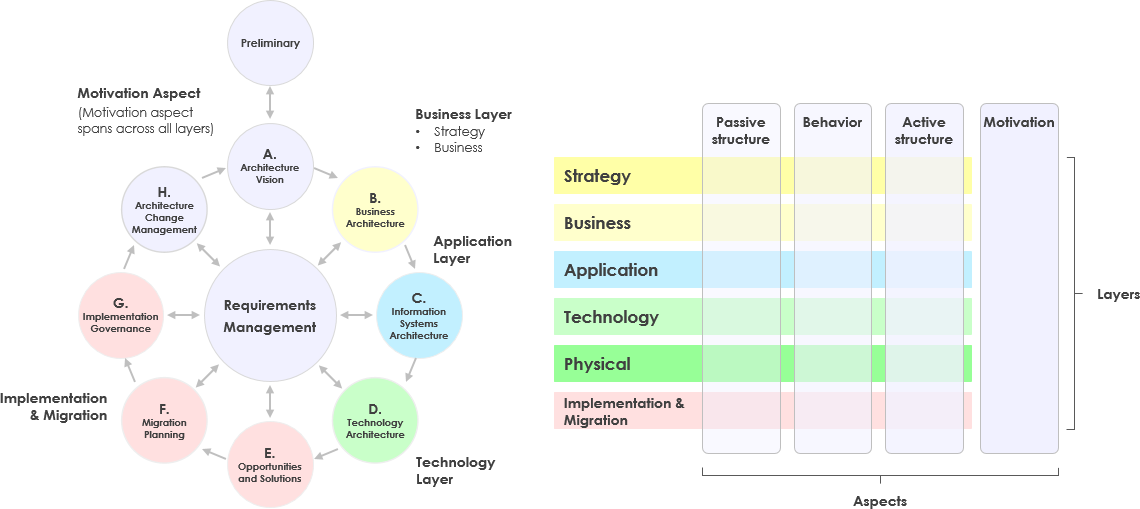
The layered approach adopted by both TOGAF ADM and ArchiMate provides a powerful and structured means to tackle complex enterprise architecture challenges. It fosters alignment, clarity, and collaboration among stakeholders across various domains and layers, ultimately contributing to more effective enterprise architecture development and management. This synergy between TOGAF ADM and ArchiMate is a valuable asset for organizations striving to excel in the ever-evolving business landscape.
ArchiMate and TOGAF ADM Layers Mapping
ArchiMate serves as a valuable companion to TOGAF ADM, offering a standardized and graphical way to represent and communicate architectural concepts. It helps bridge the gap between business and IT by providing a common language for stakeholders across various domains. Here’s how ArchiMate seamlessly fits into the different phases of TOGAF ADM:
-
Phase A: Architecture Vision:
- ArchiMate can be used to create high-level architecture models that capture the initial architectural vision.
- It helps stakeholders visualize and understand the proposed changes and their impact on the organization’s structure.
-
Phase B: Business Architecture:
- ArchiMate’s business layer provides modeling concepts to represent business processes, functions, and organizational structures.
- Enterprise architects can use ArchiMate to map out current and target business architectures and identify gaps and opportunities for improvement.
-
Phase C: Information Systems Architecture:
- ArchiMate’s application layer allows for modeling of application components, interfaces, and data flows.
- Enterprise architects can use ArchiMate to design the information systems architecture that supports the business processes defined in Phase B.
-
Phase D: Technology Architecture:
- ArchiMate’s technology layer facilitates the modeling of infrastructure components, platforms, and technology relationships.
- It helps in aligning the technology architecture with the business and information systems architectures.
-
Phase E: Opportunities and Solutions:
- ArchiMate can be employed to model alternative solution architectures, making it easier to evaluate different options.
- It aids in assessing the impact of each solution on the existing architecture and business objectives.
-
Phase F: Migration Planning:
- ArchiMate supports the development of a detailed implementation and migration plan by modeling the transition states and dependencies.
- It helps in prioritizing and scheduling migration activities effectively.
-
Phase G: Implementation Governance:
- ArchiMate’s modeling capabilities can be used to monitor and track the implementation progress of architectural changes.
- It provides a visual way to communicate the status of ongoing projects and their alignment with the architecture.
-
Phase H: Architecture Change Management:
- ArchiMate helps in assessing the impact of proposed changes on the architecture and business goals.
- It enables architects to model and communicate change requests and their implications.
TOGAF ADM as an Architecture Content Framework:
- TOGAF ADM provides a structured approach to architecture development, and it defines a core metamodel that outlines the key entities and their relationships within an enterprise architecture.
- It prescribes the creation of various artifacts, including catalogs (e.g., Business Architecture, Data Architecture, Technology Architecture), matrices (e.g., Technology and Business Information), and diagrams (e.g., Organization Chart, Application Communication), which serve as documentation of the architecture.
- These artifacts capture information about the current state, target state, and transition states of the architecture, facilitating decision-making and communication throughout the architecture development process.
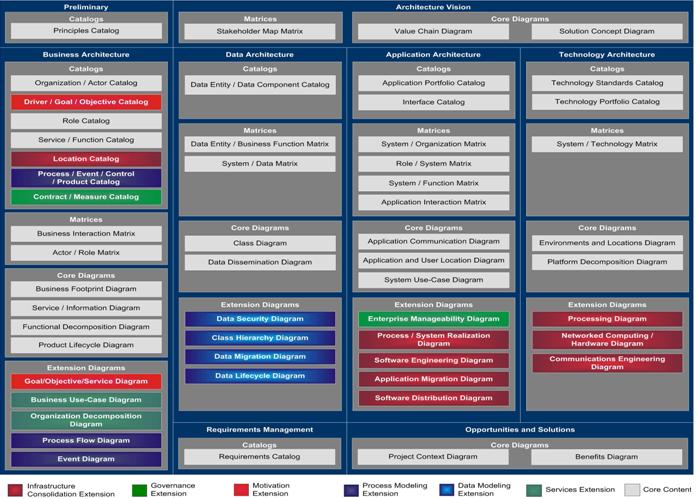
ArchiMate as a Modeling Language:
- ArchiMate, on the other hand, is a modeling language that provides a standardized notation for representing enterprise architectures. It defines a metamodel with concepts such as business processes, applications, data objects, and technology infrastructure.
- ArchiMate also establishes relationships between these concepts, enabling architects to visually depict how different architectural elements interact and influence one another.
- ArchiMate’s diagram notations, including Business Process Diagrams, Application Landscape Diagrams, and Technology Infrastructure Diagrams, are well-suited for modeling the entities and relationships within an enterprise architecture.
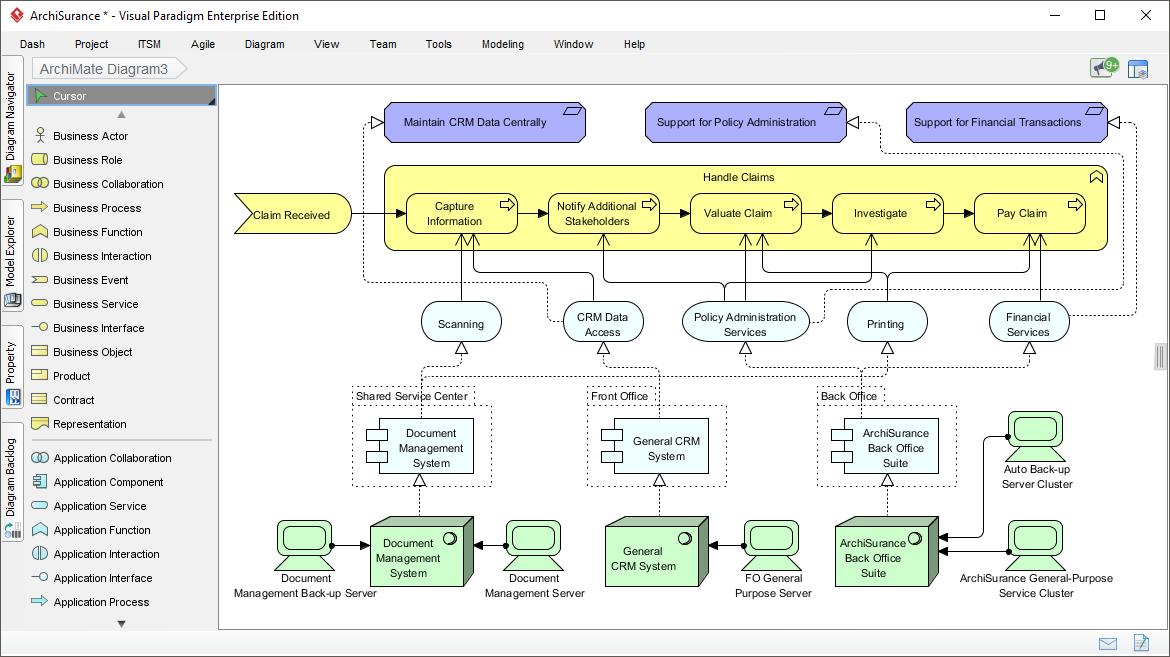
Alignment between TOGAF ADM and ArchiMate:
- There is a strong alignment between TOGAF ADM and ArchiMate in terms of their metamodels. Many of the entities and relationships defined in TOGAF ADM align closely with the concepts provided by ArchiMate.
- Most TOGAF ADM deliverables, such as catalogs, matrices, and diagrams, can indeed be represented using ArchiMate diagram notations. ArchiMate’s visual representations provide a clear and concise way to communicate complex architectural information.
- While ArchiMate excels at visually representing the architecture, TOGAF ADM complements this by offering guidance on when and how to create these artifacts within the architecture development process.
Benefits of Combining TOGAF ADM and ArchiMate:
- Combining TOGAF ADM and ArchiMate allows for a seamless transition from architectural planning and development to visualization and communication.
- Architects can use ArchiMate to create comprehensive architectural models that align with TOGAF ADM’s recommended artifacts, enhancing the clarity and accessibility of architectural documentation.
- The integration of these frameworks promotes a more structured and standardized approach to enterprise architecture development, which is essential for successful alignment with business goals and IT capabilities.
Artifacts Not Modeled by ArchiMate
While ArchiMate provides a comprehensive framework for modeling enterprise architecture, it’s important to acknowledge that there are certain aspects of TOGAF’s Architecture Development Method (ADM) that aren’t fully matched by ArchiMate’s core concepts. This discrepancy arises from the fact that TOGAF encompasses a broader scope, addressing high-level strategic concerns as well as detailed engineering aspects of system development, whereas ArchiMate primarily focuses on the enterprise architecture level of abstraction.
In particular, some TOGAF ADM deliverables necessitate the creation of non-visual models that fall outside the purview of ArchiMate. For instance, during the Phase E (Opportunities and Solutions) and Migration phases of TOGAF ADM, there is a need to specify implementation-specific requirements. These requirements, being highly detailed and specific, cannot be effectively represented using the graphical notations provided by ArchiMate.
In essence, it’s important to recognize that ArchiMate alone cannot fully capture and represent all the deliverables and artifacts required by TOGAF ADM. Instead, ArchiMate plays a crucial role in bridging this gap by providing a unified and visually intuitive modeling notation that encompasses the majority of the required visual models. These ArchiMate-based visual models are then embedded within the TOGAF ADM deliverables as artifacts, simplifying the process of enterprise architecture development and enhancing communication and comprehension among stakeholders.
Streamlining TOGAF ADM with ArchiMate Automation
Simplify your enterprise architecture journey by automating the TOGAF® ADM process using standard diagrams. Say goodbye to the hassle of navigating through stacks of documentation and reference materials.
TOGAF ADM Process Navigator: Guided Actions for Effective Processes
Visual Paradigm offers architects a visual and actionable approach to develop all the necessary deliverables throughout the TOGAF Architecture Development Method (ADM). This solution provides clear instructions, modeling tools, real-world samples, guidelines, and techniques to ensure your architecture development process is both efficient and effective.
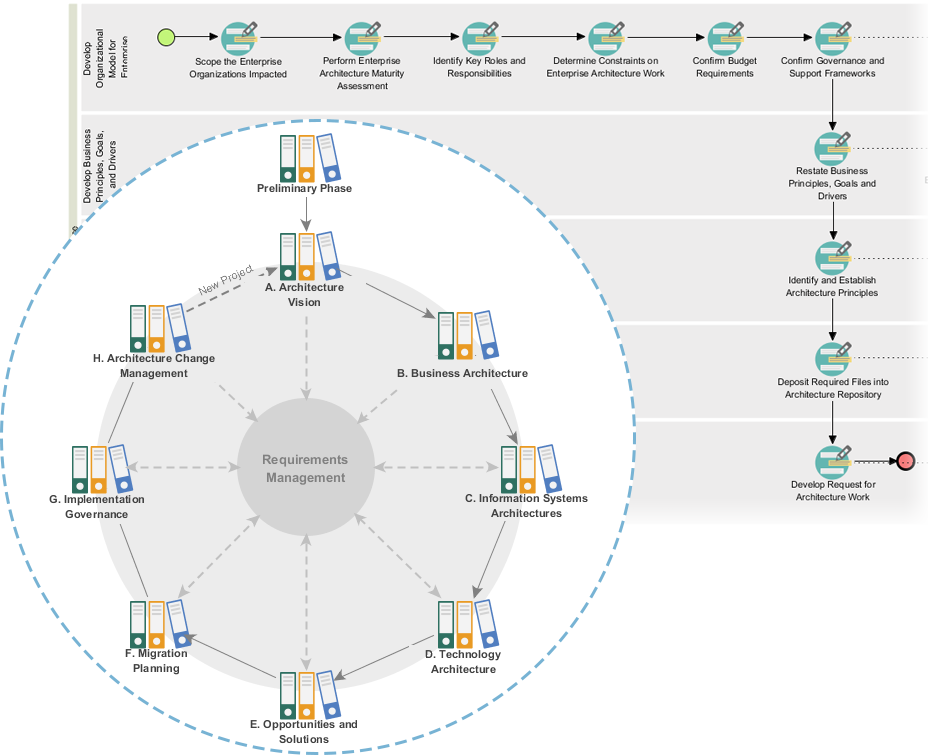
Guided Actions for Effective Processes
Effortless Form Filling with In-Line Guidance
Mastering enterprise architecture development has never been easier. Our solution eliminates the need for extensive learning. Just follow the step-by-step instructions, leverage provided samples, and complete the required information. It’s as straightforward as filling in the blanks.
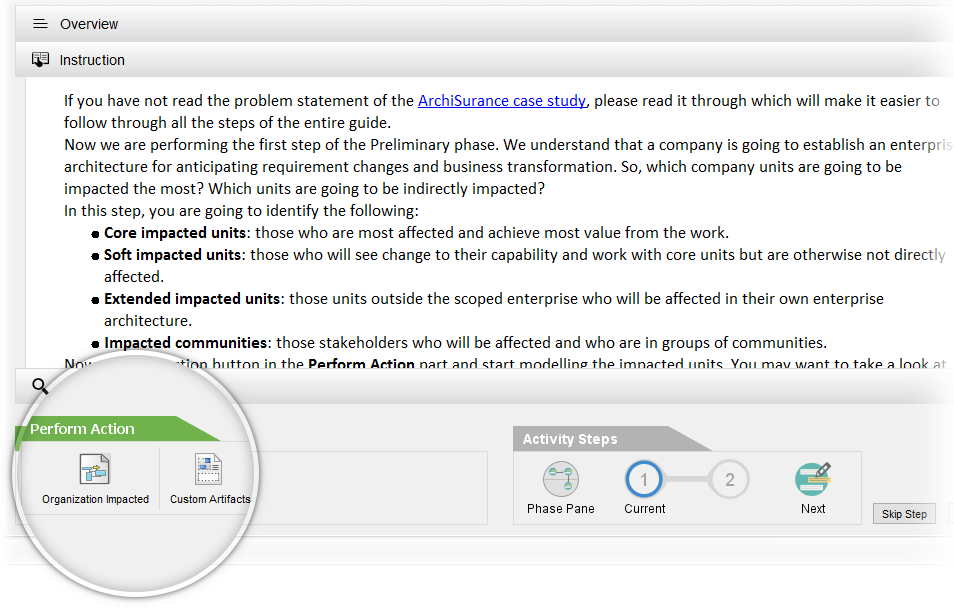
Effortless Form Filling with In-Line Guidance
Developing an enterprise architecture doesn’t require an extensive learning curve. Instead, all you need to do is follow the provided instructions and utilize the provided samples to fill in the necessary information. It’s a straightforward process that doesn’t demand a steep learning curve.

In the ever-evolving landscape of enterprise architecture, the synergy between TOGAF ADM and ArchiMate has become increasingly vital. As we’ve explored, ArchiMate serves as a powerful ally in visualizing and communicating complex architectural concepts, while TOGAF ADM offers a structured methodology for architecture development. By combining the two, organizations can streamline their architectural practices, enhance collaboration, and ultimately achieve their business goals with greater efficiency.
But what if there was a way to take this synergy to the next level, making the TOGAF ADM process even more intuitive, efficient, and accessible?
Visual Paradigm TOGAF Automated Guide-Through Process:
Visual Paradigm has revolutionized the world of enterprise architecture with its TOGAF Automated Guide-Through Process. This innovative solution simplifies and automates the TOGAF ADM journey, empowering architects and organizations to achieve architectural excellence effortlessly.
With Visual Paradigm’s TOGAF Automated Guide-Through Process:
- Simplicity Rules: You no longer need to navigate complex documentation or spend valuable time searching for references. Our solution provides clear instructions, modeling tools, real-world samples, guidelines, and techniques in one seamless package.
- Efficiency Redefined: We’ve streamlined the entire architecture development process, making it more efficient than ever. It’s like having an experienced guide by your side, ensuring that you follow best practices and complete each step effectively.
- In-Line Guidance: Forget about extensive learning curves. Visual Paradigm offers in-line guidance that allows you to develop enterprise architectures by following step-by-step instructions and filling in the necessary information with ease.
- Comprehensive Resources: Our solution doesn’t stop at automation. It also offers a wealth of resources to help you learn more about ArchiMate, TOGAF ADM, and best practices in enterprise architecture.
Don’t Miss Out on Architectural Excellence!
Visual Paradigm’s TOGAF Automated Guide-Through Process is your key to achieving architectural excellence without the unnecessary complexity. Embrace automation, streamline your processes, and make your enterprise architecture development intuitive and efficient.
Explore Visual Paradigm today and experience the future of TOGAF ADM with ArchiMate automation. Your architectural journey has never been this straightforward!
References
- What is ArchiMate?
- Full ArchiMate Viewpoints Guide
- ArchiMate 3 Update
- What’s New in ArchiMate 3?
- Using ArchiMate Tool with TOGAF ADM
- TOGAF ADM Tutorial
- The Best TOGAF Software
Unleash the power of automation and visualization to enhance your enterprise architecture practices. Make your architecture development more efficient, intuitive, and aligned with industry standards.
Conclusion
Integrating ArchiMate into TOGAF ADM enhances the effectiveness of enterprise architecture practices. It provides a standardized language and notation for modeling and communicating architectural concepts throughout the architecture development process. This seamless integration enables better collaboration among stakeholders, improved decision-making, and a more structured approach to managing architectural changes.
As organizations continue to face the challenges of digital transformation and evolving business landscapes, the combined power of TOGAF ADM and ArchiMate can prove to be a valuable asset in ensuring that architecture development remains aligned with business goals and adaptable to changing circumstances. By adopting these frameworks in tandem, enterprises can streamline their architectural efforts and drive sustainable success in a dynamic world.
In conclusion, the integration of TOGAF ADM and ArchiMate leverages the strengths of both frameworks. TOGAF ADM provides a robust methodology for architecture development, while ArchiMate offers a powerful means to visually represent and communicate architectural concepts. This synergy enables organizations to achieve greater clarity, consistency, and alignment in their enterprise architecture practices.

